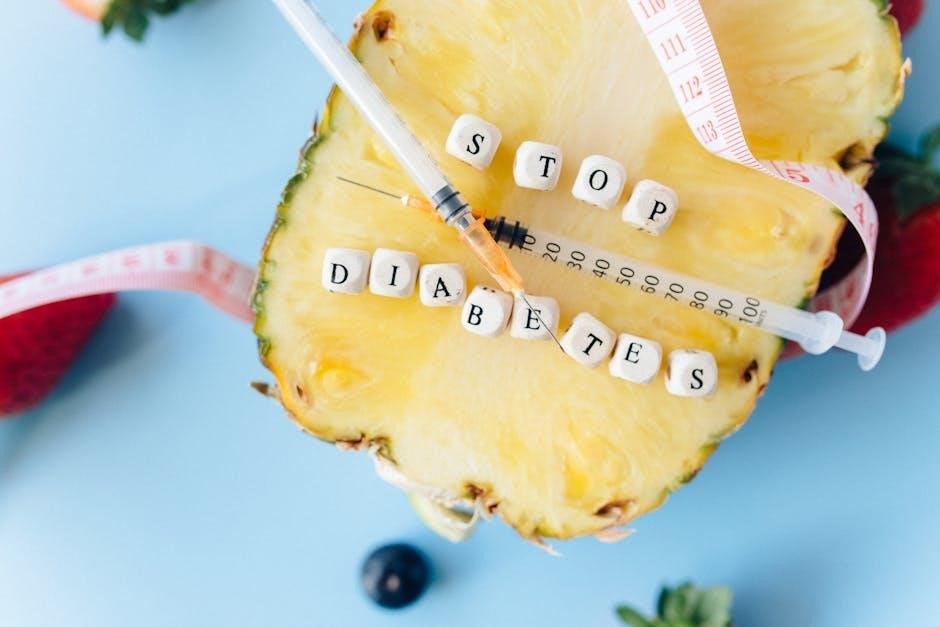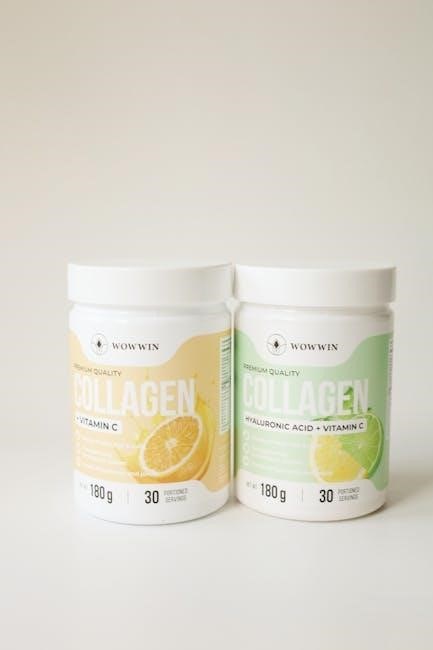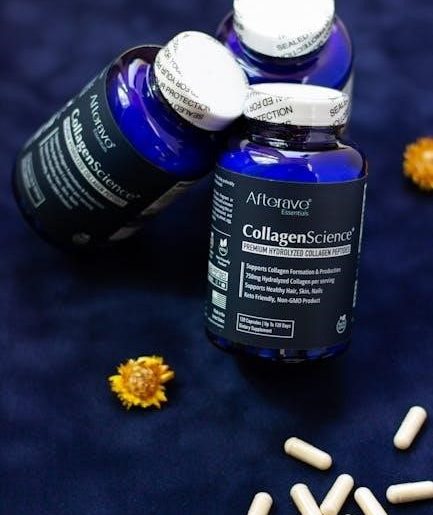Gastroesophageal reflux disease (GERD) occurs when stomach acid flows back into the esophagus, causing irritation and discomfort. It is characterized by symptoms like heartburn and chest pain.
Diet plays a crucial role in managing GERD, as certain foods can trigger acid reflux. Understanding the relationship between diet and GERD is essential for reducing symptoms effectively.
1.1 What is GERD?
Gastroesophageal reflux disease (GERD) is a chronic condition where stomach acid flows back into the esophagus, causing irritation and discomfort. It occurs when the lower esophageal sphincter (LES) relaxes inappropriately or weakens over time. This backflow of acid can lead to symptoms like heartburn, chest pain, and difficulty swallowing. GERD is a common condition that affects millions worldwide and can significantly impact quality of life if left untreated or poorly managed. Understanding its causes and mechanisms is key to developing effective management strategies, particularly through dietary adjustments.
1.2 Symptoms of Acid Reflux
The primary symptom of acid reflux is heartburn, a burning sensation in the chest that often worsens after eating or lying down. Other common symptoms include regurgitation, where stomach contents rise into the mouth, leaving a sour taste. Difficulty swallowing, coughing, and hoarseness can also occur. In severe cases, acid reflux may cause chest pain, disrupt sleep, and lead to complications like esophageal irritation or narrowing. These symptoms can vary in severity and frequency, often triggered by specific foods or lifestyle factors.
1.3 Importance of Diet in Managing GERD
Diet plays a pivotal role in managing GERD, as certain foods can trigger or alleviate symptoms. By identifying and avoiding trigger foods, individuals can significantly reduce acid reflux episodes. A tailored diet helps stabilize the lower esophageal sphincter, preventing stomach acid from flowing back into the esophagus. Incorporating alkaline and anti-inflammatory foods can further reduce inflammation and discomfort. A well-planned diet not only alleviates symptoms but also improves overall quality of life, making it a cornerstone of GERD management.

Overview of the Anti-Reflux Diet
The anti-reflux diet focuses on preventing acid reflux by avoiding trigger foods. It’s easy to follow, requiring elimination of specific items that relax the lower esophageal sphincter or delay stomach emptying. This dietary approach helps reduce symptoms like heartburn and improves digestion. By focusing on alkaline, anti-inflammatory foods, the diet supports long-term relief and overall well-being.
2.1 Benefits of an Anti-Reflux Diet
The anti-reflux diet offers numerous benefits, primarily reducing symptoms of heartburn and acid reflux by preventing stomach acid from flowing back into the esophagus. It helps avoid irritation and inflammation of the esophageal lining, promoting healing and comfort. This dietary approach also improves digestion and can prevent complications associated with chronic acid reflux. By focusing on the right foods, individuals can manage GERD effectively without relying on medications, leading to a healthier and more comfortable lifestyle overall.
2.2 Key Principles of the Diet
The anti-reflux diet focuses on minimizing symptoms by avoiding trigger foods that relax the lower esophageal sphincter or slow stomach emptying. Emphasizing alkaline, anti-inflammatory foods helps reduce acidity and inflammation. Small, frequent meals prevent overloading the stomach, while avoiding late-night eating allows for proper digestion. Staying upright after meals and maintaining a healthy weight further support digestive health. These principles work together to create a balanced and sustainable approach to managing GERD and reducing acid reflux episodes effectively.
General Guidelines for an Anti-Reflux Diet

Eat small, frequent meals, avoid trigger foods, and stay upright after eating. Maintain a healthy weight and limit fatty, spicy, or acidic foods to reduce symptoms.
3.1 Eating Small, Frequent Meals
Eating smaller, more frequent meals helps reduce stomach pressure and prevents acid reflux. Divide your daily intake into 4-6 smaller meals instead of three large ones. This approach allows the stomach to empty gradually, minimizing the risk of acid backflow. Pairing meals with fluids an hour before or after eating can further aid digestion. Maintaining this eating pattern supports a balanced digestive system and alleviates GERD symptoms effectively. Consistency is key for long-term relief.
3.2 Avoiding Trigger Foods
Avoiding trigger foods is essential to manage GERD symptoms. Foods like citrus fruits, chocolate, mint, spicy, fatty, and fried items can relax the lower esophageal sphincter, worsening acid reflux. Identifying and eliminating these foods from your diet can significantly reduce discomfort. Keeping a food diary helps track which foods trigger symptoms. By avoiding these triggers and opting for alkaline, anti-inflammatory foods, you can better control acid reflux and improve digestion. This tailored approach supports long-term relief and a healthier digestive system.
3.4 Maintaining an Upright Position After Meals
Maintaining an upright position after meals is crucial for managing GERD. Lying down immediately after eating can cause stomach acid to flow back into the esophagus, worsening symptoms. It’s recommended to stay upright for 45 to 60 minutes post-meal to allow proper digestion. This practice reduces acid reflux and discomfort, promoting a healthier digestive system. Consistency with this habit can significantly alleviate GERD symptoms over time.

Foods to Include in an Anti-Reflux Diet
Incorporate alkaline and anti-inflammatory foods to help neutralize stomach acid and reduce irritation. These include leafy greens, non-citrus fruits, and lean proteins, which promote a balanced digestive system.

4.1 Alkaline Foods
Alkaline foods are essential in an anti-reflux diet as they help neutralize stomach acid and reduce esophageal irritation. Leafy greens like spinach, kale, and collard greens are excellent choices due to their high alkalinity. Non-citrus fruits such as bananas, melons, and pears are also beneficial. These foods promote a balanced pH level in the body, which can alleviate GERD symptoms. Incorporating alkaline-rich vegetables like broccoli, cauliflower, and cucumbers further supports digestive health and minimizes acid reflux discomfort. A diet rich in these foods creates a less acidic environment, fostering healing and symptom relief;
4.2 Anti-Inflammatory Foods
Anti-inflammatory foods play a crucial role in reducing GERD symptoms by minimizing esophageal irritation and inflammation. Lean proteins like poultry, fish, and tofu are excellent choices, as they are easy to digest and promote healing. Whole grains such as oats, quinoa, and brown rice provide fiber, which aids digestion and reduces inflammation. Incorporating vegetables like carrots, green beans, and celery can also help soothe the digestive tract. Staying hydrated with water and herbal teas further supports an anti-inflammatory diet, while avoiding processed foods can prevent flare-ups and improve overall well-being.
Foods to Avoid in an Anti-Reflux Diet
Fatty, spicy, and fried foods relax the lower esophageal sphincter, triggering acid reflux. Citrus fruits, caffeine, carbonated beverages, chocolate, and mint also worsen symptoms by irritating the esophagus.
5.1 Fatty, Spicy, and Fried Foods
Fatty, spicy, and fried foods are major triggers for acid reflux. They relax the lower esophageal sphincter, allowing stomach acid to flow back into the esophagus. Fatty foods slow digestion, keeping the stomach full longer and increasing pressure. Spicy foods irritate the esophagus directly, while fried foods are high in fat, which delays gastric emptying. Examples include pizza, fried chicken, and hot wings. Avoiding these foods can significantly reduce inflammation and alleviate symptoms of GERD. Incorporating this guideline helps maintain a healthier digestive system and prevents discomfort.
5.2 Citrus Fruits and Juices
Citrus fruits and juices, such as oranges, grapefruits, and lemons, are highly acidic and can trigger acid reflux. Their acidity can irritate the esophagus lining, worsening heartburn symptoms. While they are nutrient-rich, individuals with GERD should limit or avoid them. Even small amounts can cause discomfort for some; Monitoring personal tolerance is key, as reactions can vary. Avoiding these foods helps reduce esophageal irritation and supports a healthier digestive system. This adjustment is crucial for managing GERD effectively and preventing recurring symptoms.
5.3 Caffeine and Carbonated Beverages
Caffeine and carbonated beverages can worsen acid reflux by relaxing the lower esophageal sphincter, allowing stomach acid to flow back into the esophagus. Carbonated drinks, such as sodas and sparkling water, can cause bloating, increasing pressure on the stomach and exacerbating symptoms. Reducing or eliminating these beverages can help alleviate heartburn and discomfort. Moderation is key, as even small amounts can trigger reflux in sensitive individuals. Avoiding these drinks is a simple yet effective step in managing GERD symptoms and improving overall digestive health.
5.4 Chocolate and Mint
Chocolate and mint can trigger acid reflux by relaxing the lower esophageal sphincter, allowing stomach acid to flow upward. Chocolate, especially types high in cocoa or containing caffeine, can worsen symptoms. Mint, including peppermint and spearmint, also weakens the sphincter, making reflux more likely. Avoiding these foods, particularly in the evening or close to bedtime, can help reduce heartburn and discomfort. Moderation is key, but for severe GERD, complete avoidance may be necessary to manage symptoms effectively and improve overall digestive health.
Lifestyle Changes to Support the Anti-Reflux Diet
Lifestyle adjustments, such as maintaining a healthy weight, avoiding smoking, and limiting alcohol, can significantly support an anti-reflux diet by reducing symptoms and improving digestion.
6.1 Weight Management
Maintaining a healthy weight is crucial for managing GERD, as excess weight can increase pressure on the stomach, leading to acid reflux. Even a modest weight loss can significantly reduce symptoms. Eating smaller, balanced meals and avoiding trigger foods helps achieve and maintain weight goals. Regular physical activity, combined with a tailored diet, supports overall health and reduces reflux episodes. Consulting with a dietitian or doctor can provide personalized strategies to manage weight effectively and alleviate GERD discomfort.
6.2 Avoiding Smoking and Alcohol
Smoking and alcohol consumption can significantly worsen GERD symptoms by relaxing the lower esophageal sphincter, allowing stomach acid to flow back into the esophagus. Smoking also reduces saliva production, which normally helps neutralize acid. Alcohol can delay stomach emptying, prolonging acid exposure. Quitting smoking and limiting alcohol intake are essential lifestyle changes to manage acid reflux effectively. These adjustments, combined with dietary modifications, can lead to substantial symptom relief and improved overall health for those with GERD.
6.3 Exercise and Physical Activity
Regular exercise can help manage GERD symptoms by promoting digestion and maintaining a healthy weight. Low- to moderate-intensity activities, such as walking or swimming, are ideal. Avoid high-intensity workouts, as they can increase abdominal pressure and worsen reflux. Exercising on an empty stomach or too soon after meals can also trigger symptoms. Incorporating physical activity into your routine, along with dietary changes, can enhance overall well-being and reduce acid reflux discomfort effectively.

Sample 7-Day Anti-Reflux Meal Plan
A well-structured meal plan helps manage GERD symptoms. Start your day with oatmeal and herbal tea. Include lean proteins like chicken or fish, paired with steamed vegetables. Opt for non-citrus fruits and whole grains. Avoid trigger foods and ensure meals are small and frequent. Incorporate alkaline foods like green vegetables and non-acidic fruits. Stay hydrated with water and limit caffeine. End the day with a light dinner, avoiding heavy meals close to bedtime. This plan provides balanced nutrition while minimizing acid reflux triggers.
Tracking Progress with a Food Diary
Tracking your meals and symptoms in a food diary is crucial for managing GERD. It helps identify trigger foods and monitor symptom patterns. By recording portion sizes and how symptoms feel after eating, you can make informed dietary adjustments. Consistently updating the diary provides valuable insights over time. This tool aids in personal management and helps healthcare providers understand your condition better, leading to more effective treatment plans.

The Role of pH Levels in Foods
Foods with higher pH levels are less likely to trigger acid reflux, as they are less acidic. Alkaline foods, such as vegetables and certain fruits, help neutralize stomach acid. Avoiding acidic foods like citrus, tomatoes, and vinegar can reduce reflux symptoms. Understanding the pH levels of foods helps in making informed dietary choices to manage GERD effectively.
Adopting an anti-reflux diet can significantly reduce GERD symptoms and improve overall well-being. Download our comprehensive PDF guide for a detailed meal plan and lifestyle tips.
10.1 Summary of Benefits
An anti-reflux diet offers numerous benefits, including reduced heartburn, improved digestion, and enhanced overall health. By avoiding trigger foods and incorporating alkaline, anti-inflammatory options, symptoms are alleviated. This diet is easy to follow, focusing on small, frequent meals and upright posture post-meal. It also promotes weight management and reduces inflammation. Long-term adherence can prevent complications and improve quality of life. Download our PDF guide for a structured plan to achieve these benefits and manage GERD effectively.
10.2 Encouragement to Download the PDF Guide
Take control of your GERD symptoms with our comprehensive 7-day anti-reflux diet plan PDF. This guide provides practical tips, delicious meal ideas, and expert advice to help you manage acid reflux effectively. Designed for easy printing and meal prepping, it ensures a smooth transition to a healthier lifestyle. Download now and start your journey toward reduced discomfort and improved well-being. Say goodbye to heartburn and hello to a symptom-free life with our expertly curated guide!
